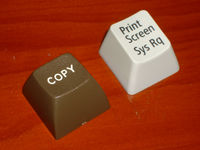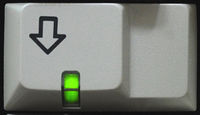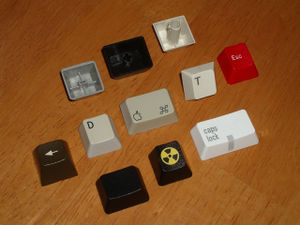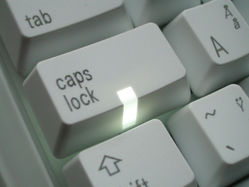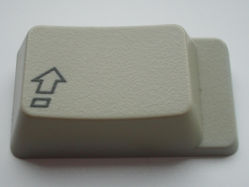Keycap
A keycap (sometimes referred to as a keytop) is the part of the key that the user presses with his or her finger, and it is the only part of the key that is typically visible. Keycaps bear the legend for the key (the marking indicating the key's purpose), and they are removable parts that often can be easily detached (using a keypuller) for cleaning or replacement.
Properties
Over the decades, keycaps have gained a number of characteristics that differ from one keyboard to another.
- Mount
- The keycap mount is the method by which the keycap is affixed onto or into the switch. Keycaps can be a press fit onto a moving shaft called the slider, or they may be a single moulded part.
- Inscription
- There are numerous methods for printing legends onto keycaps, each with pros and cons; the majority of modern keyboards have pad printed legends. For assistance with learning to type and for aesthetic reasons, some people prefer to eschew legends altogether, and it was the creation of such a blank keyboard that began Metadot's foray into the keyboard market
- Keycap profile
- Keycaps are for the most part either cylindrical profile (modern full-travel keyboards), flat (many laptops and some recent desktop keyboards), or spherical profile (vintage keyboards).
- Keyboard profile
- Keyboard profiles differ between brands and keyboard types
- Purpose
- Keycaps serve a serious purpose of identifying the function of each key; stock keycaps can be replaced with novelty keycaps for decorative purposes. By extension, there are group buys for replacing the entire set of keycaps with replacements
- Window
- Many keyboards place the lock LEDs under the respective keycaps, with transparent or translucent windows in the keycaps to let the light through
- Size and shape
- Even within a particular keycap mount (e.g. Cherry MX mount keycaps designed for Cherry MX-based keyboards with a 0.75ʺ unit size), keycaps of a particular function (e.g. shift, enter) differ in both size and shape from one keyboard manufacturer to another and from one country to another. For example, the enter key shape and size differs between ANSI and ISO keyboards, and the size of the various modifier keys varies widely by brand. Even the space bar varies widely in size. Certain keycaps may have a stepped shape.
- Material
- A number of different plastics have been used to construct keycaps
LED windows
"Windowed" keycaps are keycaps with a transparent window that is placed above an LED. Some keyboards use LEDs within or beside the switch instead of within a panel, and the light from the LED shines out through the window in the keycap. The window itself is typically a piece of transparent plastic that is inserted inside the keycap proper. Cherry MX switches in particular are notable for having a recess for mounting an LED inside the switch without any detriment to the switch.
Keyboards designed for video and audio editing work can be found with significant numbers of windowed keycaps.
Windowed Fujitsu Peerless keycaps, showing the precision window insert; the slot for the insert was damaged during its removal
Illuminated caps lock key in a Matias Tactile Pro 3
Stepped keycaps
Centre stepped and non-stepped keycaps on a Cherry G84-4400
Backlit keycaps
Backlit keyboards require special keycaps with transparent legends.
The most common approach appears to be thick paint: the keycap is made out of transparent material, and thick paint is applied to provide the opacity. This paint can wear off with use.
Backlit keycap from a KBC Poker II
